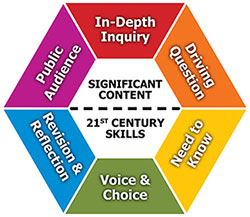What can we learn about teaching and learning from these teachers?
In all of these videos, we are getting some great information from teaching and learning through project based learning. In the first video Back to the Future by Brian Crosby, he shared with us his journey of teaching children that were second language students. Upon taking a survey on the second day of school, he found out that most of them did not have the basic skills that are needed to make it in the world. Brian took the kids and started teaching them through project based learning and the results were truly amazing. His students were blogging and experimenting to learn. They even did a really creative project where they had to pretend like they were a balloon. The project was immensely successful and taught the students a lot. They were not just sitting behind a desk with a pencil and a piece of paper. Brian's teaching us that project based learning is the best way to teach a class. Brian goes on to state, “The student are fired up about learning." The way that the students enjoy learning shows us that project based learning is what they prefer as well. The connections and publicity that the students received were amazing. It created huge responses from their leaning network of other students wanting to do some of the same fun and educational thing that they were doing in Brian’s classroom. This video is just one of the many that shows us what we can learn about teaching and learning from teachers.
In the second video Blended Learning Cycle by Paul Anderson, we see the styles of learning come together which are blended learning and the learning cycle. Upon putting the two together, he was able to create his own acronym called QUIVER. Paul goes on to show us the importance of starting with a really good opening question which happens to be the meaning of the first two letters in QUIVER. The question has to be intriguing to the students to make them want to learn more about the given topic. The "I" stands for investigation/ inquiry. You have to allow the students the time to do their own investigating. The "V" stands for video. The students get the chance to watch a video on the subject matter. The "E" stands for elaboration. That's where the time needs to be taken out for elaborating more on the subject matter to give the students a clear understanding. The “R” stands for Review. The review process is where the teacher finds out by meeting with the students if they are understanding or not. The last letter "S" stands for summary. In this step, a summary quiz will be given. Paul gave some really helpful information in his video that will help us as aspiring teachers. The driving question is always the most important step to a successful project.
In the third video Making Thinking Visible featuring Mark Church, his class is using project based learning to invoke a deeper understanding of what they are studying. They are given a question about what they have already learned so far. They are told to come up with a headline for the topic. We learn from Mark that Project based learning is the best way to get all the students involved and excited about learning. The students all seemed to be very focused and excited to learn.
In the fourth video Sam Pane 4th Grade, Sam's students are taught how to be safe on the internet by building their own super hero. Sam taught us the importance of keeping the students safe while they are doing online actives. He comes up with a really neat project for his students that has to do with them creating their own comics. Through the comics, the students are taught how to be a good digital citizen. At the end of the project, the students are able to share what they have created. This video is another wonderful example of the power of project based learning.
The fifth video called Project Based Learning by Dean Shareski, shows us about project based learning on a different spectrum. The students are in an extended class and they are leaning through project based learning. Throughout the day they switch around to the three different teachers that they have in the classroom and they are learning different subjects that are all blended together. These teachers are showing us that benefits of project based learning given the time frame that they are allotted to teach these kids. The students are motivated about learning and are able to cover so much more material. The students definitely respond well to this type of learning. It forces them to want to do better on the projects.
In the last video Roosevelt Elementary’s PBL Program, we are able to see from these teachers that project based learning is making a huge impact on the students. The students are not just doing enough to get by. They are actually learning in detail about the subject matter. One of the reasons that they are taking a liking to this learning is because they get to make their own choices. The students are also getting the experience of real world skills that will be taken with them. All these projects the students are doing has a little bit of every subject mixed in to one. Also in this video the parents are excited that their children are comprehending and learning so much. All of these videos have project based learning as the main learning point.

Hi Shira! I enjoyed reading your post this week. It was very informational and organized. You also did a great job of incorporating links and pictures. I got a lot out of the videos for this blog post as well. I think Sam Pane's video was my favorite! Great job! :)
ReplyDeleteGreat job!
ReplyDelete